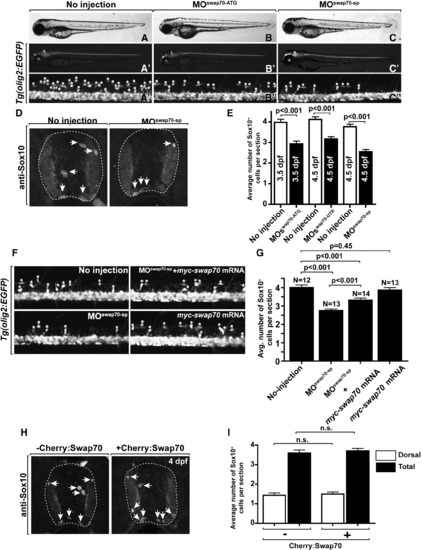Fig. 6
- ID
- ZDB-FIG-111128-5
- Publication
- Takada et al., 2011 - swap70 Promotes neural precursor cell cycle exit and oligodendrocyte formation
- Other Figures
- All Figure Page
- Back to All Figure Page
|
swap70 regulates OPC number. Lateral views of wild-type (A?A3), MOswap70-ATG (B?B3) and MOswap70-sp (C?C3) larvae at 3 dpf. Asterisks in A3, B3, C3 mark dorsally migrated olig2:EGFP+ OPCs. MO-injected larvae appear to have fewer OPCs than wild type. (D) Transverse sections showing Sox10+ OPCs (arrows) in the spinal cord of wild-type and MO-injected larvae at 4.5 dpf. (E) Quantification of OPCs reveals statistically fewer OPC in MO-injected larvae at 3.5 and 4.5 dpf. (F, G) swap70 overexpression by mRNA injection partially rescues the OPC deficit produced by MO knockdown. (F) Lateral view of Tg(olig2:EGFP) spinal cord at 3 dpf. Asterisks mark dorsally migrated OPCs. (G) Quantification of Sox10+ OPCs on spinal cord sections at 3 dpf shows that myc-swap70 overexpression reduces the OPC deficit caused by swap70 MO but does not alter OPC number in the absence of MO. (H, I) Transgenically induced Cherry-Swap70 does not alter OPC number or distribution. (H) Transverse sections through spinal cords of control and Cherry-Swap70 overexpressing larvae. Arrows point to Sox10+ OPCs. (I) Quantification of dorsally migrated and total OPCs in control and Cherry-Swap70 overexpressing larvae reveals no differences. White bars indicate the number of dorsally migrated OPCs. Black bars indicate the total OPC number. n.s., not significant. |
| Genes: | |
|---|---|
| Antibody: | |
| Fish: | |
| Knockdown Reagents: | |
| Anatomical Term: | |
| Stage Range: | Protruding-mouth to Day 4 |
| Fish: | |
|---|---|
| Knockdown Reagents: | |
| Observed In: | |
| Stage Range: | Protruding-mouth to Day 4 |
Reprinted from Molecular and cellular neurosciences, 48(3), Takada, N., and Appel, B., swap70 Promotes neural precursor cell cycle exit and oligodendrocyte formation, 225-35, Copyright (2011) with permission from Elsevier. Full text @ Mol. Cell Neurosci.

